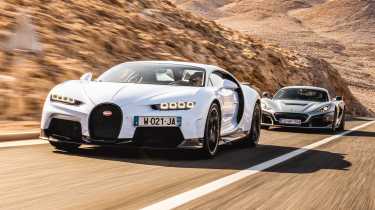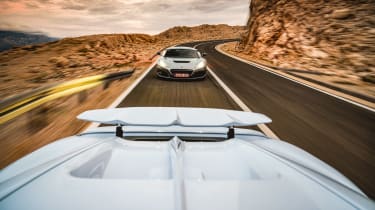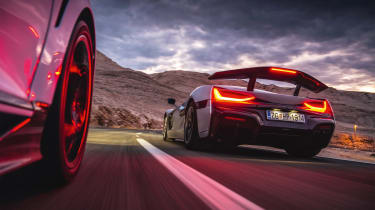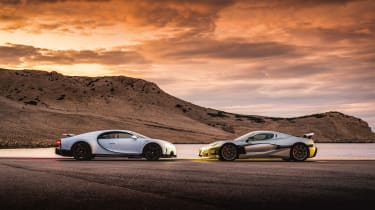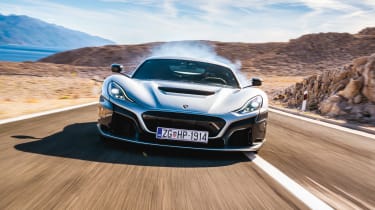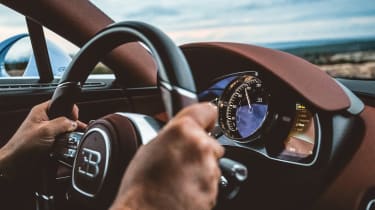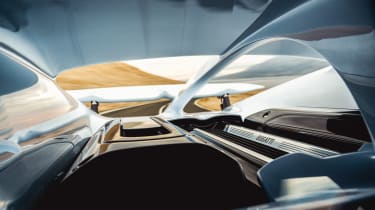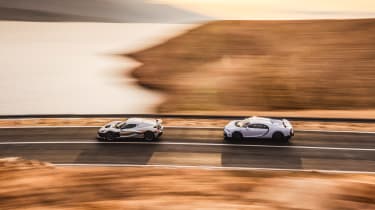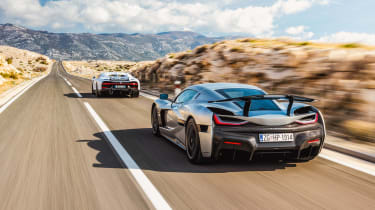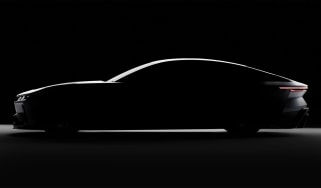Bugatti Chiron Super Sport v Rimac Nevera
Bugatti’s next hypercar will be built under the ownership of EV experts Rimac. We drive the current ultimates from both marques on the stunning roads of southern Croatia
Watching the tail end of a Bugatti Chiron Super Sport squirm under full acceleration as all four of its vast tyres scrabble for grip momentarily is not, let’s face it, a sight many folks will ever get to witness up close and personal, in real life. But even if you are fortunate enough to see a Chiron SS in full flight as it thunders its way from zero to 62mph in 2.4sec and to 186mph (300kph) in just 12.1sec, it will inevitably be a blink-and-you’ll-miss-it experience, a seismic event that’s already unfolded long before you’ve had time to focus in on the details.
Unless, that is, you happen to be sitting behind the Bugatti at the controls of a Rimac Nevera, in which case you’ll have all the time in the world to drink in what happens when the Chiron’s driver tries, and for half a second fails, to dump all the raw energy produced by its 8-litre quad-turbo W16 engine not-so-neatly onto the tarmac. For the record the Super Sport generates 1600 PS or 1578bhp – officially. But unofficially it’s a fair bit more than that; the biggest number we’ll see on its power output dial during two days of driving it will be 1611 PS, although apparently the figure 1616 quite often pops up in the display if you keep your toe in for long enough and hit a high enough speed.
Either way, it’s more than the car’s ESC system can cope with on roads such as those we’re on today, hence the reason the Chiron goes sideways in a spectacular WRC-style launch-cum-drift when its driver – in this case one Andy Wallace – gives it the beans from a standstill. It’s one heck of a thing to observe from no more than 10 yards away, even though the dust cloud kicked up by the Bugatti’s spinning rear Michelins does spoil the view after a couple of seconds.
Where it all gets a bit surreal, however, is when you realise how hard the Rimac doesn’t have to try to keep up with the flailing Bugatti. Give the Nevera any more than three-quarters throttle and you’d slam straight into the Chiron’s gearbox, simple as that. The car from Croatia is genuinely that much faster when they leave the line together, and it stays that way until you’re way beyond 200mph. It just disappears out of sight, never to be seen again, physically and/or metaphorically.
At which point you can’t help but ask yourself a question: what the actual fudge is going on here? I mean, when did the Chiron Super Sport – still officially the world’s fastest road car thanks to the efforts of Mr Wallace himself, who in 2019 clocked 304.77mph in a pre-production example without the 273mph speed limiter of the customer cars – stop leaving every other hypercar in its wake? Did something weird happen during the pandemic? Did we skip a decade somewhere in the evolution of the ultrafast car and somehow no one told Bugatti? Did a meeting take place in which the established space-time continuum got shifted to a different part of the universe? Seriously, what the heck happened, and when?
Electricity happened, that’s what. Or to be more precise, some of the world’s cleverest car and software engineers got together and worked out a way to make one large battery pack, four electric motors, four separate gearboxes and zillions of different algorithms combine to produce a level of propulsion that’s never been seen before in a road car. By a factor of about two. They then made all this unfeasibly clever technology available under the roof of just one extraordinary car called the Rimac Nevera. And the rest, as they say, is history.
Except it’s not quite as simple as that, because the same people who’ve just spent the last decade turning the Nevera into The Almighty Being of hypercars are now responsible for creating the next range of Bugattis as well. Which is where it all gets a bit complex, not least for the dear old Chiron Super Sport, whose petrol-powered W16 engine and conventional seven-speed dual-clutch gearbox would appear to be out of the ark compared with what’s available in aisle B+ of the factory at Rimac Technology nowadays.
If you’re confused by the whole ‘who owns what and how’ within the Bugatti-Rimac hierarchy, allow me to explain. In simple terms the Rimac Group is now the kingpin of the empire and is financially backed by an enviable collection of investors that includes Porsche, Hyundai and Goldman Sachs, to name but three. As well as helping Porsche and Hyundai develop their EVs, Rimac also does development work for all sorts of other car companies – from Koenigsegg to Aston Martin to AMG – and understandably trousers an increasingly tidy amount of money in the process. But Rimac Group also owns 55 per cent of a new company called Bugatti Rimac, the remaining 45 per cent being owned by Porsche, and this is the company that will be making Bugattis from now on.
Bottom line: the money made by the Rimac Group, including Bugatti Rimac and Rimac Technology, effectively funds the existence of Rimac Automobili – which makes the Nevera – and this is what’s enabled CEO Mate Rimac and his team of 1500 or so employees to produce the world’s fastest, and very probably its best, electric car.
Seemingly this has happened out of the blue, but in fact Rimac has been in business for about the same amount of time as McLaren Automotive, so maybe we shouldn’t be at all surprised that the 256mph Nevera is as breathtakingly brilliant as it is, straight out of the box. Even so, it’s hard not to be blown away by just how polished this car is purely as a product. How beautifully well made it is inside and out, even beside the majestically expensive-feeling Bugatti. How perfectly it rides, how sweetly it steers, how well judged its throttle and brake pedals are, and how fundamentally composed it is when you’re just bumbling about in it, watching the Chiron in front rumble and gorge its way across the Spaghetti Western landscapes of southern Croatia.
And when the Bugatti gets a bit too far ahead, and photographer Aston Parrott asks you on the walkie-talkie to close the gap by a couple of hundred yards so the picture he’s taking from across the valley looks better balanced, all you do is brush the Nevera’s accelerator momentarily and, whoompf, you’re right back where you need to be, nailed once again to the Chiron’s tail. The time it takes to cover ground in this car is not measured by conventional means. Instead, you arrive where you want to be in it instantly. Then your brain needs a moment to catch back up.
In this specific sense, the Nevera is not like any other road car I’ve driven before, and because there are no gearchanges as such, and not a lot of noise to accompany the almighty thrust it delivers either, it’s easy to get seriously freaked out by what it can do, to simply fail to compute what’s going on momentarily because the forces at work are so unusual.
The danger, of course, is that it’s so quick, so punchy, you can arrive where you want to be an awful lot sooner – and travelling a heck of a lot faster – than you anticipate. On quick motorbikes they call it speed shock. But in a car that weighs 2150kg and can produce similarly violent hits of acceleration so readily, the effects are even harder to process somehow. So you really do need to think very clearly indeed – about your geographical surroundings, as well as the state of your own head – before you just open it up and try to hang on. Because if you don’t, the car itself hangs on just fine but your brain, especially the bits that deal with balance and spatial awareness, does not. And for a second or so you can feel quite spaced-out as the inner workings of your mind struggle, and fail, to keep up. It’s a fantastically disturbing experience the first time you open the Nevera up properly on the public road, but it’s not an especially good one to encounter if, say, you’re sitting behind someone who’s trying to hold on to a Bugatti Chiron Super Sport that’s going slightly sideways, because the recipe for disaster is ripe.
As the miles pass we’ll learn more and more about what these two extraordinary cars are all about. What you can and can’t get away with when driving them quickly – or slowly – on the road. How different they feel to one another in some ways, how weirdly similar in others, and why between them they represent where we are right now in the world of the hypercar, where we’ve been, and maybe where we’re heading next.
Their prices alone will make you laugh or cry, or both. The Nevera costs around 2.4 million euros including taxes, the Bugatti 3.2 million, so call it a nice round five million in sterling for the pair. Both are four-wheel drive but, of course, only one has an engine in the traditional sense, the Nevera’s propulsion instead being provided by a liquid-cooled 120kWh lithium battery pack that powers four individual electric motors via four separate gearboxes for combined totals of 1888bhp and 1740lb ft.
The Bugatti is more than 300kg lighter at 1995kg to the Rimac’s 2300kg, which is quite some realisation when you look at them in the flesh. The Chiron is massive by comparison, its long tail, wider bodyshell and enormous as opposed to merely vast rear tyres exuding far more physical presence than the smaller, more compact, less ostentatious-looking Nevera. Not that the Rimac looks anything other than thoroughly intriguing in isolation. The difference is, people know exactly what the Chiron is even from 100 metres away. The Nevera they have no clue about. Unless you happen to be in Croatia, in which case casual observers quite often drop and do the full Wayne’s World ‘we are not worthy’ routine – because in Croatia, Rimac is royalty.
The same theme continues inside. The Chiron feels far bigger from behind the wheel and its cabin is much more luxurious in look, feel and even smell. This car’s mix of tan and dark blue hides, and its bigger steering wheel that features the letters E and B in its centre, exude an impossibly expensive aura that’s far more ostentatious beside the more business-like interior of the Nevera, which is more compact inside and features Alcantara fabrics rather than swathes of uniquely provenanced leather.
Both have great seats and fine driving positions, but the Nevera is the easiest to see out of, especially to the rear because there’s no engine back there to see past. It’s also easier to climb into and out of, Rimac having designed the driving position so that your knees are behind the rearmost arc of the front wheelarch – again a result of there being no conventional powertrain to package.
On start-up the Chiron’s engine makes the earth move ever so slightly, and it’s a magnificent thing to experience. It’s not an overtly loud noise but it is a highly complex one, a series of screams and whooshes underscored by a base rumble from somewhere deep within its guts, indicating that the warming of fluids and god knows what else is taking place. It sounds like doom, and beside it the Nevera, well, it just starts. The only indication that it’s ready to go is visual and comes in the form of three small horizontal lights that illuminate along its flanks. These also tell you which driving mode it’s in: Range, Cruise, Sport, Track or Drift. Only in Drift do the lights glow orange (rather than blue) so that’s obviously the one to be seen in when you roll up outside the yacht in Monaco, just to show your audience what a superhero you truly are behind the wheel.
On the move, the Bugatti is the more comfortable car initially, although you can switch between drive modes in the Chiron, too, in order to sharpen or soften its dynamics accordingly. Your options are more limited though, and range from ‘EB’ to ‘Autobahn’ and ‘Handling’ and in each instance the car goes into a completely different dynamic set-up, with even the ride height altering to make it either more slippery or more stable at speed.
The difference is, in the Nevera the modes affect the car’s personality at all speeds, making it either more playful or more benign (or just more efficient) depending on what sort of mood you’re in, and what kind of road you’re driving on. And the changes happen instantly, the moment you rotate the magic button in the middle of the centre console. In the Chiron the modes are predominantly there to make the car more stable at high speed, not necessarily more fun, to a point where Wallace isn’t keen on me driving it on motorways in anything other than Autobahn mode because the stability isn’t as optimised for the conditions in EB or Handling.
It also takes a good couple of seconds for each mode to fully engage, there are that many hydraulic motors in the Chiron, each one needing to do its thing to set the wings and ride height levels to the desired points. It feels quite clumsy beside the Nevera in this respect, which simply snaps between modes in milliseconds, albeit with a physical thump from behind as the big rear wing either deploys or retracts into the rear bodywork depending on which mode you’ve selected.
On the move the Nevera feels immediately smaller, more agile, quieter and more urgent than the Bugatti – quite a lot more urgent to be honest. Which is a quite ridiculous thing to become aware of when the other car you are talking about has nearly 1600bhp. But truly, this is the way it is. Yet once you get past the pure intimidation factor, the way the Chiron shrinks on the move is amazing, and after a while you realise you can drive it far harder than you thought possible so long as there’s the space in which to operate, mainly because it controls its inertia so very well. Plus it has a massive amount of grip.
You can push and sometimes even party a bit with the Chiron, and it doesn’t bite, doesn’t get wild. Instead it flows from corner to corner on a tsunami of torque and poise, its thunderous sequentially turbocharged W16 engine providing you with a constant source of temptation. It will fire you out of any corner and down any straight with three times more energy than you’ll ever need, or sometimes even want.
I also love the way its seven-speed gearbox picks off gears so cleanly and so fluidly whenever you squeeze the upshift paddle, no matter how many revs are showing. Same on the way back down, when it’s just really nice to be able to downshift on the way into corners, to be able balance and guide the car more accurately under deceleration, even though the Chiron’s vast brakes are more than capable of slowing it down all on their own. It’s the complete opposite of the Nevera in this respect, in which you rely solely on the power of the brakes to dump speed on the way into a corner, there being no gears with which to downshift. This is one of the few aspects that elevates the Bugatti beyond the Rimac subjectively when you swap between the two.
But here’s the thing, here’s the crunch. However charming and majestic and stupefyingly fast the Chiron is in isolation – and it is still an insanely fast and lovely thing to drive – it is nowhere beside the Rimac dynamically. Not even in the same universe. The Nevera can go round corners, accelerate along straights, stop for corners, generate traction on the way out of them, turn into them, sit cleanly and feel perfectly balanced in the middle of them in a way that the Chiron can’t even contemplate. Yet it also feels more engaging, more communicative and just more alive beneath your hands and backside at the same time. Often by quite some margin.
Fair enough, you can’t just top-up the Nevera with electricity as readily as you can a Chiron with petrol, as we discovered when we ran them both dry at the end of day one and had to Google-search where the nearest fast-charge station was. But the next morning all it took was a 40-minute drive to a 98-octane-equipped gas station that also had a fast charge point on its forecourt. The Bugatti took five minutes to fill at a cost of well over £100; the Nevera took 19 minutes to recharge and cost less than a third of that. And both cars were good for another 300 or so miles from that point.
In many ways, the Rimac Nevera makes the Bugatti Chiron Super Sport feel like a dinosaur. Don’t shoot the messenger, as they say, but the message is clear: petrol is now over when it comes to ultimate performance cars, at least as the sole means of propulsion. I’m not sure how comfortable I feel about writing that, but there it is nonetheless.
However, having said that, a mixture of the two – petrol and electricity – could be the holy grail for a car like the Chiron’s replacement. Imagine a hypercar powered by a charismatic and high-revving W16 that didn’t have turbos but, instead, used a full-blown EV powertrain not unlike like the one that propels the Nevera to add some more spice at the other end. A lot more spice. Now that really would be something else…
Specs
| Bugatti Chiron Super Sport | Rimac Nevera | |
| Engine | W16, 7993cc, quad-turbo | 2 x 220kW front, 2 x 480kW rear |
| Power | 1578bhp @ 7050-7100rpm | 1888bhp |
| Torque | 1180lb ft @ 2250-7000rpm | 1740lb ft |
| Weight | 1995kg | 2300kg |
| Power-to-weight | 651bhp/ton | 834bhp/ton |
| 0-62mph | 2.4sec | 1.97sec (with 1ft roll-out) |
| Top speed | 273mph (limited) | 256mph |
| Basic price | c£2.8m | c£2.1m |
This story was first featured in evo issue 307.
